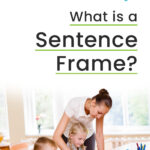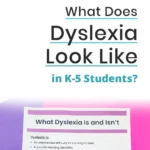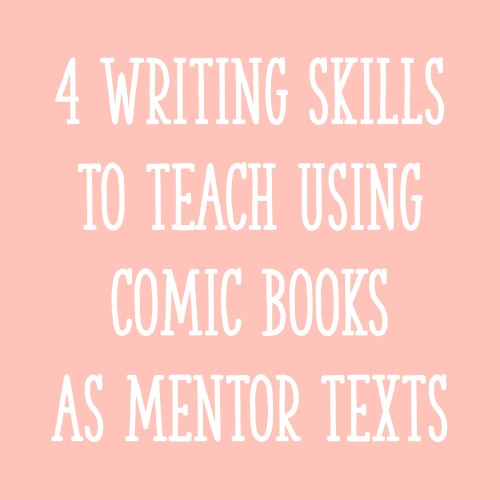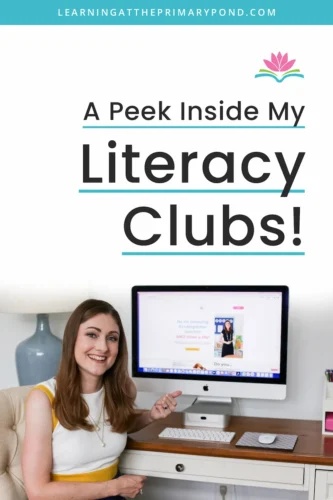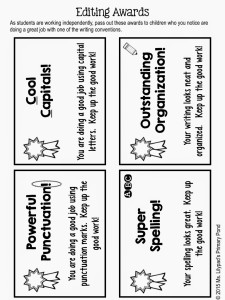As kids grow from tiny tots to curious students, they are immersed in spoken language. Those first babbling sounds turn into words, sentences, and entire conversations. Speaking and listening lay the groundwork for literacy, preparing children to eventually read and write. Clearly, speech is an important precursor (for most children) to being able to read and write. So what should we, as teachers, know about this topic?
In today’s blog, I am thrilled to bring in some assistance! Danelle V. has been a speech-language pathologist for 31 years, working with both children and adults. This post will provide you with some insight into how speech and literacy are connected. She’ll also share some tangible ideas to use with your students, share with their parents, or even try out with your own children at home!
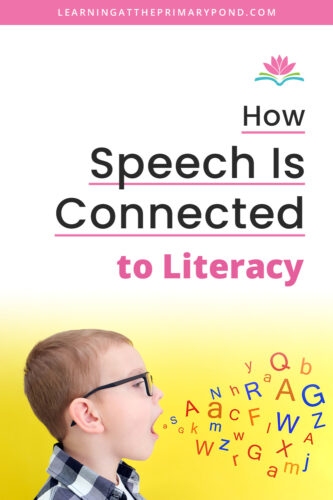
How Speech Is Connected to Literacy
About Me
Hi! My name is Danelle V. I currently reside in Wisconsin, where I work as a speech-language pathologist in elementary schools. Initially, I completed my undergraduate degree at the University of Wisconsin Whitewater and then obtained my master’s degree at Florida State University.
I’ve worked in many different settings over the past couple of decades – school districts, home health agencies, hospitals, private practices, and nursing homes. Additionally, I have worked in Birth to 3 programs that serve the youngest of learners who may need some extra support those first few years.
One of the best things about being a speech-language pathologist is the wide variety of settings to work in with many diverse populations. Communication is truly the key to it all!
What can teachers/parents do to model and build speech?
One of the best things you can do is simply talk to your kids! I highly recommend putting away the electronic devices when you’re able to! Here are a couple more simple ideas to model speech with little ones:
- Play, play, and play some more – kids learn through play!
- Modeling speech is key for kids to learn language and how to communicate. When kids are really young (under 18 months), they’re absorbing everything that you are teaching them. You are using vocabulary, describing things, teaching them about different words, and offering them speech models on how to communicate.
- Read to your kids every day. You don’t even have to read the words in the book, just talk about the pictures. Make it silly and fun! Get books from the library on things that they’re interested in. When you are reading, kids are hearing the inflection in your voice, the silly voices, and ultimately how sentences work.
You have already started preparing them for literacy and reading by providing them with good models of what speech and literacy look/sound like.
What are some other simple ways to promote speech in a child’s everyday life?
You can incorporate whatever sounds you want kids to work on in your day-to-day lives. For example, if you want your student to work on the /s/ sound, do these activities while on a walk…
- “I see a /S/LIDE, /S/WINGS, /S/IDEWALK.
- “Can you show me how to /S/PIN?”
- “Point to the /S/KY!”
The grocery store is also another great place to incorporate speech! Let’s say you’re working on the /l/ sound – point to the /L/EMONADE, /L/EMONS, /L/IMES. As you stand in the produce section of the store, say “I am thinking of something that starts with a /l/ sound.” Hold up a banana and a lemon and have them pick which one starts with the /l/ sound.
What is “normal” as far as speech for early students?
I always refer people to the developmental milestones that are listed here: https://www.asha.org/public/speech/development/chart/
ASHA is the American Speech Hearing Learning Association. You’ll be able to find great resources that are based on research on their site!
What indicators are there for parents/teachers that there may be an issue with speech for a child?
Extra supports may be needed if a child is several months behind in an area (such as articulation, receptive or expressive language, fluency) listed on the AHSA site. These indicators could show up in many ways, but here are a few examples:
- the child doesn’t seem to understand simple directions
- the child isn’t using any words to communicate
- the child gets frustrated while trying to communicate
What should a parent/teacher do if there is concern about a student’s speech? What action might they take?
First, have the parent bring up speech concerns with the child’s pediatrician to talk more about developmental milestones. Then, the parent and pediatrician can work together to make a plan!
Additionally, there are laws in place to help support students with speech issues or delays. For children who are (from) Birth – 3 years of age, there are agencies around the country that hold contracts to both evaluate and work with children who have needs. Here’s an example of the Birth to 3 Program in my area – Milwaukee Birth to 3 Program.
If a child is 2 ½ years of age, you can contact your local neighborhood school. Public school systems are responsible for meeting the needs of children with special needs as they turn three years of age. Hence, you can begin the process before his/her 3rd birthday so if a child does qualify for services, those services can begin on his/her 3rd birthday.
What are some areas that speech-language pathologists support students with?
Speech-language pathologists work with children who have delays in their:
- phonological or articulation skills
- understanding of language (auditory comprehension or receptive language)
- ability to verbally express themselves (expressive language)
- fluency skills – this could be a child who is dysfluent or may be a stutterer
- cognition – memory skills, executive functioning skills, etc.
- language, such that they need augmentative or alternative communication (speech-generating device)
If a child is working with a speech-language pathologist, how can a teacher/parent complement their work?
- Learn the strategies, techniques, and cues that the speech-language pathologist is using.
- Ask for items to continue to practice in class/at home.
- Ask to sit in a session occasionally so you are directly watching how the child is being cued and the methods that they are utilizing.
- Practice, practice, and practice! Remember that practicing does not mean sitting at a table for 15-20 minutes. You can practice anywhere…. walking in the hallways, outside at recess, at lunchtime, etc. You can provide good models and gently cue a child for the right sound, strategy, or technique.
To sum these points up, do your best to partner with the speech-language pathologist! You’re all on the team, and working together is how progress is made.
Does speech progression follow a similar progression/scope to phonics?
In some ways, yes. We work on phonological or articulation skills in a very similar structure to phonics. We use research to know how and what to teach. Phonics, literacy, and speech therapy go hand in hand – when children can recognize letters/sounds, they will do better with their speech production and vice versa.
What’s an example of a lesson a speech-language pathologist would do while working with a student?
Here’s an example of a few things I might do with a student struggling with the “sp” blend (i.e. words that start with “sp”):
- First, I’d do a tremendous amount of modeling (visually, verbally and tactile cues) with words beginning with the “s” blends.
- I’d introduce the /s/ as a *sizzle* (“ssssss”).
- Then, I’d show them with my finger in the air or up the arm to replicate holding the “s” sound* for a long time – “ssssss.”
- Next, I’d show them that the /p/ sound is a “lip popper.” For this, I cue by taking a finger and *popping* it off of the lips.
- I’d then try to model the “sp” blend by still using two clear sounds so kids understand that there are in fact two sounds in the one blend.
As they are able to produce the two sounds, I’d then go to activities that put the two sounds together. Again, all of this must be done with a significant amount of modeling, cueing, and encouragement. Here are some additional “sp” activities we may do in a lesson:
- Read books with “sp” – SPOOKY books, books that have SPOTS in them (such as “Spot” the dog,) SPACE books, etc.
- Look at things that SPIN (could be our own bodies or other objects!)
- Play with cars and call them SPEEDY fast
- Talk about outer SPACE
- Sing “The Itsy Bitsy SPIDER”
Again, all of this must be done with a significant amount of modeling, cueing, and encouragement.
If you’re trying to get a child to read/write a certain sound, but they can’t pronounce it, what should you do?
In this situation, I’d correctly model saying the word and how to segment the sounds for them. Over-exaggerate the sound that may be difficult. You could then consider having the student repeat back the word and sounds to you. Here’s an example with the word “spot”:
- The child is trying to write the word “spot,” but they are saying “sot.”
- Say “The word is ‘spot.'” (As you do this, really put a slow emphasis on the /p/ sound.)
- Segment the word for them – “/s/ /p/ /o/ /t/” (Again, really exaggerate that /p/ sound.)
- Consider asking the student to repeat the word and sounds back to you.
- Support them in writing the word sound by sound as they segment it back to you.
You’ll have to decide, though, if the child is able to be asked to “try it again” by gauging the frustration level. If you think after modeling, the child is willing to try to repeat the word and sounds, ask them to! However, if the child will shut down altogether if asked to try again, avoid this step.
It’s so important to watch their self-esteem and social-emotional growth because the process should be completed in a kind, thoughtful way. You don’t want the child to become self-conscious or feel bad about themselves. For speech, literacy, and really in all things, kids always work for people that they are invested in! Levity, laughter, and fun go a long way!
Conclusion
Thank you to Danelle for all of her valuable insight! If you have other questions for her, feel free to put them in the comments, and we’ll pass them along to her!
Happy teaching!

